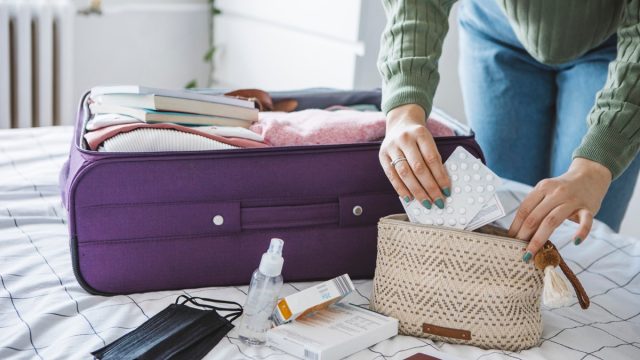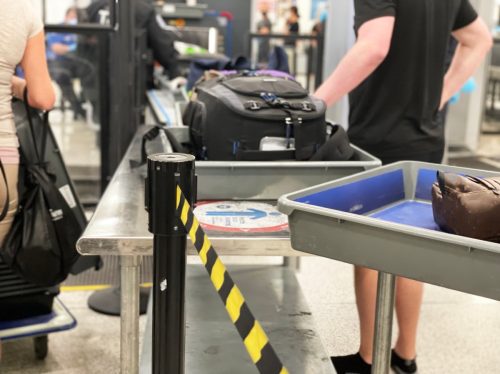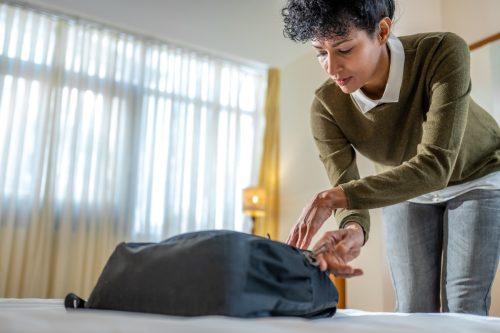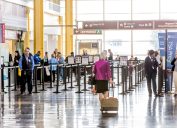TSA Issues New Alert About What You Need to Pack Before Flying
The agency is teaming up with FEMA to give urgent guidance to travelers.

Traveling can be stressful for anyone. Once you get to the airport, you have to check in, make your way through security, and beat bustling crowds to arrive at your gate on time. But the real work starts even before you show up for your flight. The U.S. Transportation Security Administration (TSA) is now teaming up with another government agency to issue an urgent new alert to travelers about what you need to consider when packing. Read on to discover what TSA says you must be including in your bag.
RELATED: TSA Issues New Alert on What You Can't Bring Through Security.
TSA is teaming up with FEMA to issue a new alert to travelers.

In a national press release posted Sept. 12, TSA announced that it had joined forces with the U.S. Department of Homeland Security's Federal Emergency Management Agency (FEMA). The two agencies have issued a new public service announcement (PSA) for travelers, urging them to "make a plan and be prepared before traveling" in case of emergencies.
"The Department of Homeland Security works day-in and day-out to keep the American people safe, but we cannot do it alone," Secretary of Homeland Security Alejandro N. Mayorkas said in a statement. "Everyone has a role to play when it comes to staying safe, especially when traveling. Natural disasters and emergencies could happen at any time, so it is important to be prepared."
RELATED: TSA Officers Just Revealed the 6 Things They "Never Do When Flying."
There are three steps you can take to get prepared for emergencies before you travel.

FEMA Administrator Deanne Criswell and TSA Administrator David Pekoske are featured in the PSA, reminding travelers that they can work to keep themselves or their family safe when traveling for work or on a vacation.
"It's as simple as one, two, three," Criswell says in the video.
The first step is to "assess your needs," according to the PSA. "Whether needing to keep your medications cool or getting help with an assistive device, it's important to understand what you'll need in an emergency," the TSA explains in its release.
As a second step, the two agencies are also urging travelers to use a support network by getting a trusted friend or neighbor to watch their home while they're away.
And last but not least, you need to make a plan.
"From planning your travel route to understanding the risks you might face in the places you visit, it's important to understand what you'll need and what you'll do when a disaster or emergency happens when you travel," the release states.
RELATED: 6 TSA-Banned Items You're Forgetting to Take Out of Your Bag.
But remember that certain items are prohibited in your carry-on.

Packing items you or your loved ones may need before traveling is one of the most crucial ways to make sure you're prepared in case of an emergency or natural disaster. But you still need to make sure you know what you're prohibited from taking through airport security.
"Check to see what you may bring in your carry-on and what you will need to place in checked baggage," Pekoske warns in the PSA.
According to Pekoske, part of being prepared is not having any prohibited items in your carry-on luggage.
"A reminder that firearms are not allowed in any carry-ons, but they are allowed in checked baggage if declared with the airline and packed properly," he adds in the alert.
RELATED: 5 Surprising Items TSA May Flag You for at Airport Security.
You can check online to see if what you're packing is allowed.

You never know when or how disaster will strike. The agencies warn that "extreme weather events are increasing in frequency and severity nationwide." With that in mind, they are advising travelers to pack an emergency kit among their items before traveling.
According to the U.S. Department of Homeland Security's website, there are numerous supplies you should consider keeping in your emergency kit—but remember that not all of them are allowed in your carry-on.
For instance, officials recommend including several gallons of bottled water. But the TSA does not allow that inside your carry-on, unless the bottle follows the 3.4-ounce or less liquid rule. FEMA also recommends putting tools like wrenches or pliers in your kit. However, airport security will not allow tools longer than 7 inches in your carry-on baggage.
"These items must be packed in your checked bags," the TSA states on its website.
If you're not sure what else you can or cannot bring, you can use the agency's online tools or contact them.
"When travelers are packing their bags and any items they may need in their emergency kit, it is important they check the TSA.gov 'What Can I Bring' tool," the release states. "For other questions on items to bring, they may also reach out to AskTSA by texting TRAVEL or 275-872, tweeting @AskTSA on X or sending a Facebook message to AskTSA."
RELATED: For more up-to-date information, sign up for our daily newsletter.
- Source: https://www.tsa.gov/news/press/releases/2023/09/12/fema-tsa-share-public-service-announcement-encouraging-travelers
- Source: https://www.ready.gov/kit
- Source: https://www.tsa.gov/travel/security-screening/whatcanibring/items/bottled-water
- Source: https://www.tsa.gov/travel/security-screening/whatcanibring/items/tools





















